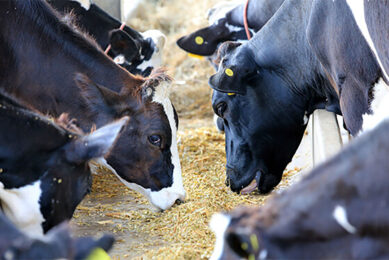Enhance dairy health and productivity with RFCs

Adding refined functional carbohydrates (RFCs), to diets throughout a dairy cow’s life cycle can help improve immune function by providing a defence mechanism for multiple pathogens the animal is exposed to over time.
In turn, these healthier animals spend less time in the sick pen (even during the vulnerable transition period), require less treatment and produce more milk.
Unique blend of RFCs
The product combines a unique blend of RFCs into a single, all-natural formulation that replaces multiple feed ingredients. RFCs are the components harvested from yeast cells (S. cerevisiae) using specific enzymes during a proprietary manufacturing process. This enzymatic hydrolysis yields:
- MOS (Mannan Oligosaccharides), which support consistent growth of beneficial bacteria like Lactobacillus and Bifidobacterium
- Beta 1,3-1,6 glucans help support the immune system and bind mycotoxins, which provides protection to intestinal cells
- D-Mannose binds pathogenic bacteria like E. coli and Salmonella
- Other RFCs help prevent certain protozoa like Eimeria (coccidiosis) and Cryptosporidium from attaching to the intestinal wall and causing disease
RFCs have a multi-functional nature
Dairies can purchase multiple sources of these ingredients, but when they are combined into a single, unique offering, RFCs cost a fraction of their parts. Because of the multi-functional nature of RFCs (reducing the effects of harmful pathogens including Salmonella and E. coli, as well as toxins in feed) less energy is needed for fighting infections and supporting the immune system.
Thus, dairies are able remove a live yeast product and a beta glucan product from their lactating and transition cow diets, replacing it with RFCs, with no slow-down in milk production or reduction in milk quality that can sometimes accompany ration changes.
Also mitigates mycotoxins
The product’s ability to bind to mycotoxins offers another key benefit to animal health and well-being. Globally, as high as 75% of ration ingredients are contaminated by one or more mycotoxins. Most fungi are able to produce several mycotoxins simultaneously and the ones produced depend on the feedstuff and crop growing conditions.
It’s well documented that mycotoxins can suppress a cow’s immunity, reduce nutrient utilisation, alter reproductive performance, reduce feed consumption, irritate tissues (especially in the gastrointestinal tract) and cause cellular death.
Researchers are also learning more about the ties between gut health and overall immune function, especially as it relates to mycotoxins. This is of key interest because immune suppression is one of the ways mycotoxins exert their effects.
A healthy gastrointestinal tract is essential
Intestinal cells are the first cells to be exposed to mycotoxins, and often at higher concentrations than other tissues. Maintenance of a healthy gastrointestinal tract is crucial to ensure nutrients are absorbed at an optimum rate and the tract can provide efficient protection against pathogens through its own immune system.
The result affects the animal on 2 levels:
- locally (at the point of attack) and
- systemically if the release of inflammatory compounds reduces immunity in other parts of the body.
That ripple effect begins when gut health is compromised and tissues are irritated. This often opens the door for opportunistic diseases that also reduce immune function. In the end, if animals are fighting off a health challenge, whether locally or systemically, it affects the energy available for other biological process.
It’s time to approach mycotoxins in the same way dairies have successfully addressed subclinical milk fever and subclinical ketosis. Assume they are present and take steps to proactively manage your herd to reduce their negative effects.
Research shows that RFCs can bind mycotoxins and prevent them from being absorbed through the gut and into the blood circulation. The toxins then pass harmlessly through the digestive system and are excreted without negatively affecting animal performance (See image below).
Immune suppression reversed
In addition, immune suppression caused by mycotoxins can be reversed by beta 1,3/1,6 glucans and mannans present in RFCs, allowing the cow to further protect itself against pathogens. As a result, nutrient uptake is maintained, leading to better feed efficiency and animal performance.
This level of protection enables animals to devote energy to all functions instead of staving off infections or struggling to maintain nutrient uptake. Therefore, using RFCs in your rations acts as an insurance policy and helps manage unseen threats, protecting animals from the ill effects of mycotoxins and other bacterial pathogens that can occur at any time.

Author: Dr Neil Michael, manager, Global Technical Services, Arm & Hammer Animal Nutrition
To learn more, visit AHanimalnutrition.com.
References available upon request.
Join 13,000+ subscribers
Subscribe to our newsletter to stay updated about all the need-to-know content in the dairy sector, two times a week.







